It was still dark out when I walked down the steps of Pension “Das Sofa” and reached the cobblestone street. I was tired from the long drive up from Berlin and birding the day before. Bikes occasionally rumbled down the street, the bikers’ breath fogging in the cold air. Hendrik walked up, having locked his bike in front of the library. Then Jochen was there, and it was time to get moving, time to go birding, after, of course, the all-important stop for coffee, baguettes, and candy; fuel for our bird-finding mission.
Our first stop, once the sun came up and the birds were visible, was the bridge over the Peenestrome, which connects the island of Usedom to the mainland city of Wolgast. Great Cormorants, Herring, Great Black-backed and Black-headed Gulls, and Greylag and Greater White-fronted Geese flew over the bridge. European Robins, Great Tits, and Eurasian Wrens (conspecific with the North American Winter Wren but maybe an eventual split) called from the bushes. I got my first look at the European Robin as we walked back to the car and was surprised that it was so small and its chest was so orange. Redwings flew over a couple of times, their high-pitched flight call easy to pick out once Hendrik told me about it. Then two Hawfinches flew over, identified by Hendrik and Jochen, but I didn’t count them as my American eyes saw only two odd finches flying over and I couldn’t identify them by ear. I didn’t know it then but that lousy and uncountable look was the only one I would get at them.
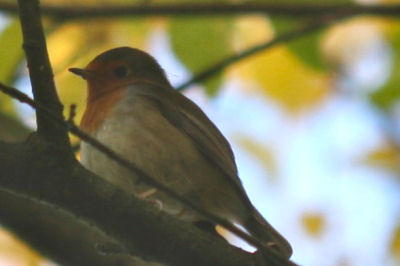
European Robin
Enough about birds that I missed; there were plenty that I saw! As we drove narrow country roads I got my first really good looks at a Rook. No, not the chess piece, but the crow-like corvid with a grayish-white patch of bare skin at the base of its bill. Then some Wood Pigeons flew off in the distance with distinctive white transverse bands on their wings. Common Skylarks gave us fly-by looks as well, their white outer tail feathers reminding me of Vesper Sparrows. And Common Gulls and Black-headed Gulls fed in the fields too, though we soon left them behind for the trees in a small village.
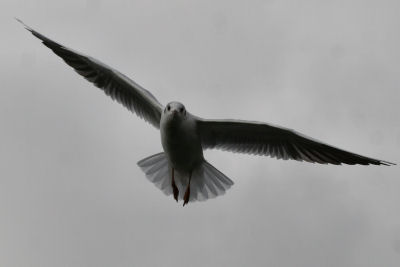
Black-headed Gull (photo actually taken in Berlin)
High pitched sounds from conifers signified Goldcrests, kinglet-like birds that were a lifer for me. Following them led to some perched European Greenfinches whose most memorable marking to me, perversely, was the yellow on their wings, and then to Eurasian Siskins, which, because they were juveniles and/or females, were not that impressive. But still, three lifers in about a minute! Talk about some good birding! Jochen was also happy to point out the Eurasian Collared-Doves that lived in the village and I was kind of angry that I had spent so much time tracking one down in New York.
After that we went back to the fields, but quickly stopped for some roadside Eurasian Tree Sparrows, yet another lifer.
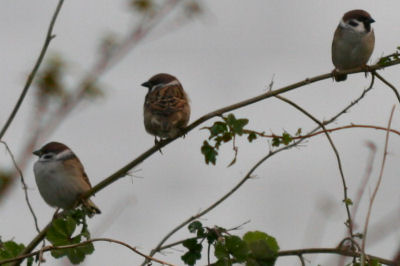
Eurasian Tree Sparrows
Then we pulled up to a field where many gulls were feeding, mostly Black-headed and Common Gulls again but Jochen pulled a Mediterranean Gull out of the mix and the scope I had borrowed from Mike came in very handy when observing its faint mask. Oh, did I forget to mention that a bunch of European Golden-Plovers were also feeding in the fields with some Northern Lapwings? And that two Red Kites were perched on power poles? And that a Great Spotted Woodpecker flew over? Well, yeah, those birds were there too, to say nothing of the large flock of Fieldfare that contained at least one Redwing that gave better looks than the flyovers from earlier on the morning.
We continued along, stopping to ogle an adult White-tailed Eagle just sitting on the ground and later to see a very pale Common Buzzard chase a Eurasian Kestrel off of a power pole perch. Then we stopped again and had a bunch of Blue and Great Tits, not a very exciting stop until Hendrik spotted my life Eurasian Goldfinch! At this point I was about ready to curl up and die of happiness but Jochen and Hendrik insisted that things would get still better so I agreed to continue birding.
We arrived at Peenemunder Hacken (the “u” in Peenemunder has an umlaut but I can’t make it appear), a beach bordering the Baltic Sea and a pine forest. It was a historical location where, during World War II, V-1 and V-2 rockets had been produced, making the area a target for allied bombers, which means that, sixty-some odd years later, bomb craters were still visible throughout the pine forest.
History AND birding in one trip! And the beach! Talk about a good time! If only it had been summer when the beach-goers are naked…
But I digress. The walk to the beach through the pine forest yielded my first look at the Eurasian Jay, a bird with far too many field marks to describe here. It’s enough to say that it was one heck of a cool-looking bird and a very welcome addition to my life list. Then, on the beach itself, were two distant Eurasian Oystercatchers, one of which is below.
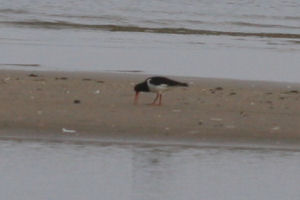
Waterfowl on the sea included Great Crested, Red-necked, and Horned Grebes, Long-tailed Ducks, Red-breasted Mergansers, Eurasian Wigeon, and, most importantly, Common Scoters, which, if I remember correctly, are still considered the same species as the North American Black Scoter but will probably be split sometime in the near future (they do have a longer tail and a less prominent yellow bump on the bill). Scanning the remaining shorebirds netted us a Red Knot, Dunlin, and Black-bellied Plovers, nice birds, but nothing I can’t see in New York. The wonderful looks at a White Wagtail on the beach were very much appreciated though (sorry for flushing it Jochen), as were the close looks at a Hooded Crow.
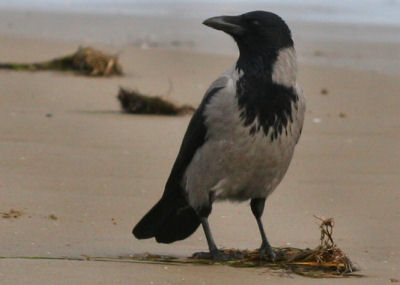
Hooded Crow
Then we walked back through the pine forest, coming across a large mixed flock of forest birds, that, in addition to the usual Great and Blue Tits included at least one Coal Tit (lifer), several Crested Tits (lifer), and a Eurasian Treecreeper (do I really need to keep doing this whole “lifer” thing?). We also got good looks at a perched Eurasian Wren and a Great Spotted Woodpecker. And, though Jochen scoffed at the waste of good birding time, I also photographed this cool slug (I don’t know what it is but if I kept a slug list it would be a lifer).

Shortly before noon, after our productive walk through beach and forest, we took a break to eat and make plans for the impossible mission: to find a Pink-footed Goose.













That’s quite a morning of birding!
sounds like my back garden this morning – NOT! great trip eh…
Comon Corey be honest… You got all those birds at the Berlin Zoo!
Sounds awesome! BTW, I couldn’t resist looking up your slug: http://en.wikipedia.org/wiki/Black_slug (Maybe this guy?)
What a great morning, Corey! And brilliantly capped off by your sighting of a black slug, Arion ater. (European slugologists, can you confirm or deny this ID?) Whatever you do, don’t pick up one of these fellows. They have really, really, REALLY sticky slime that is very difficult to wash off. I know this because I collected a bunch of these and other slugs and snails on a field trip to the UK. I dumped the lot in the bath to sort into species. After doing so, I decided to have a shower. I gave the enamel a bit of a wipe over before getting in.
It didn’t work.
As I slipped, I thought two things: a) I hope I don’t hit my head, and 2) if I do, I wonder what the Coroner’s report will say.
@Mike and Charlie: Yeah, not a bad morning…
@Will: No, but I nearly messed myself when I saw this bizarre looking bustard in Tiergarten before realizing that it was in a cage in the zoo that borders the park.
@Patrick and Snail: Thanks for the ID…I think that it must be a black slug.
Hi Corey!
What can I say: it was a very nice morning, but nothing out of the ordinary, really. The Med Gull was a good find.
Come back in May !!!
Or August!!!
September would be okay, too!
Heck, October was good enough!